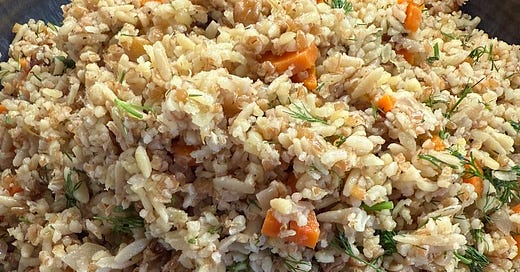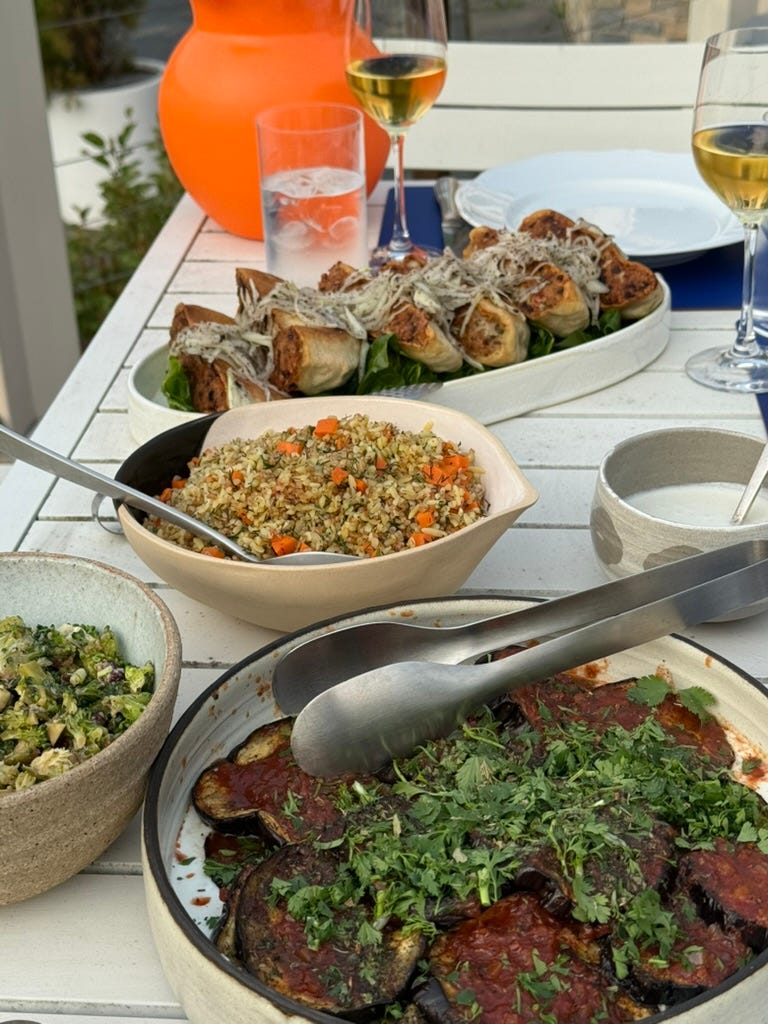Issue #211: Bulgur and Orzo with Carrots and Dill
My Technique for Cooking Grains, A Simple, Crowd-Pleasing Recipe
I’ve changed the way I cook grains.
For years I’ve been frustrated by the results of the traditional “pilaf method.” That method has you sauté aromatics in oil or butter, stir in the grain to coat, add seasoning and just the right amount of hot liquid, cover, and simmer until the liquid is fully absorbed and/or evaporated, revealing a fluffy, flavorful pilaf when you lift the lid. At least that’s the theory. Honestly, I almost never get the ratio right and my pilafs are often wet and gloppy.
It must be genetic.
I recall my mother fretting over the illustrated instructions on the back of the Uncle Ben’s box, which suggested a modified pilaf method that called for 2 ¼ cups of water and ½ teaspoon of salt for each cup of “converted" rice. In fact, I think the whole reason to “convert” rice in the first place, that is, to refine and par-boil it, is to make it foolproof. As their marketing campaign once declared, “Uncle Ben’s, perfect every time.”

As any Japanese rice expert will tell you, the amount of water rice—and presumably any grain—will absorb depends on many factors, such as where, how, and how long ago it was harvested and the degree to which it has been polished or otherwise refined. Japanese engineers have developed sophisticated appliances that can determine the exact amount of water and pressure required to cook a particular rice to perfection.
I know of no such devices for other grains, though. How’s a cook to get it right?
As with many food matters, Italy offers some advice. There, they cook most grains, including rice, the way they cook pasta, that is, in abundant salted water until al dente. Then they drain the grain, return it to the pot, set the pot over low heat or just use the residual heat from the burner, cover, and let steam until it’s finished cooking.
Years ago, I settled on a similar technique to cook basmati rice, which I shared in Issue #84. I soak rinsed basamati in abundant water, bring it to a boil, drain it, and return it to the pan to steam and finish cooking. Perfect every time.
Now I cook all my grains more or less this way.
Boiling grains in copious water keeps the grains separate and removes excess starch, making them lighter and fluffier. It requires no precise measuring of liquid because you drain off any excess water. The grain absorbs only as much as it can.
To add flavor, I sauté aromatics and vegetables, add some seasonings, and stir them in at the end, once the grain is cooked. A dab of tomato paste or white miso, a little chicken stock or white wine, add umami and depth.
A nice thing about this technique is it allows you to mix different grains together, as long as you adjust boiling times accordingly. Add those grains that cook the longest, such as pearled barley, to the boiling water first, then add the next, so they finish cooking at the same time. I often add some small pasta, such as orzo, as well, for texture and flavor.
Recently, I used this technique to make a bulgur salad for a dinner party that was so tasty, the next day one of the guests asked for the recipe. What recipe? I just boiled the grains, drained them and let them steam, and then added a sauté of carrots and onions and a handful of fresh dill.
Sensing I was onto something, I reprised the same dish for a large celebratory Shabbat dinner for 30 people last Friday. Because you don’t have to worry about precise measurements when using this technique, scaling up or down is really easy.
Bulgur is wheat that is cracked and pre-cooked, so it only takes a few minutes to cook the second time around. (Perhaps they should call it “converted” wheat.) For this dish that everyone loved, I combined two kinds of bulgur, an extra-large-grain Turkish bulgur and a smaller-grain red bulgur, and I also threw in some orzo. Use this recipe as a guide and do it up however like.
RECIPE: Bulgur and Orzo with Carrots and Dill
Makes 6 servings
Salt
1/3 cup orzo
1 cup large-grain bulgur (I use a mixture of ⅔ cup large Turkish bulgur and ⅓ cup red bulgur)
¼ cup extra-virgin olive oil
1 medium white onion, finely chopped
2 medium carrots, peeled and finely diced
¼ cup pine nuts, chopped walnuts, or sliced almonds (optional)
Finely grated zest of 1 lemon
Freshly ground black pepper
1 bunch dill, fronds and soft stems only, chopped
Bring a large pot of water to a boil and add a generous amount of salt. Add the orzo and boil for 3 or 4 minutes. If using different bulgurs, add the larger grain bulgur first and cook a couple of minutes, then add the smaller grain bulgur and keep cooking for 4 or 5 minutes until the orzo is al dente. Drain well in a sieve. Do not rinse. Return to the pot, cover, and set over the lowest heat to steam and dry for about 5 minutes, stirring occasionally so it doesn’t stick to the bottom. (If you have an electric burner, you can just use the residual heat.) Keep warm.
Meanwhile, heat the olive oil in a sauté pan. Add the onion and a pinch of salt and cook until it begins to soften, about 2 or 3 minutes. Add the carrots and cook until tender. Add the nuts, if using, and cook until they are just toasted. Stir this mixture into the cooked bulgur, using a rubber spatula to make sure you get all of the flavorful oil out of the pan. Stir in the lemon zest and a decent amount of freshly ground black pepper. When the bulgur has cooled to almost room temperature, add in the chopped dill, tossing with a fork to incorporate and fluff. Taste and adjust the salt. Serve slightly warm or at room temperature.





